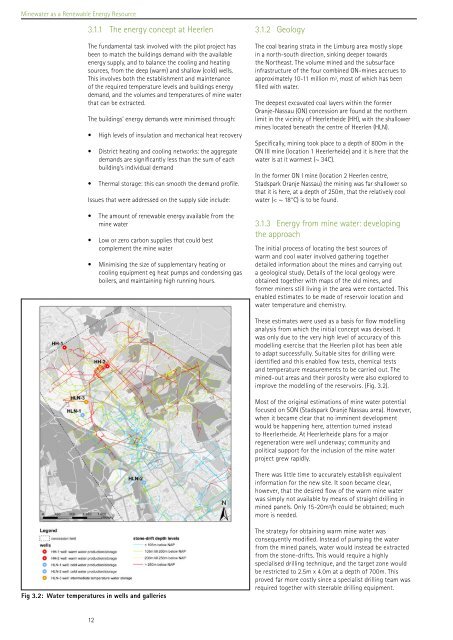Mine water as a Renewable Energy Resource - Promoscene
Mine water as a Renewable Energy Resource - Promoscene
Mine water as a Renewable Energy Resource - Promoscene
Create successful ePaper yourself
Turn your PDF publications into a flip-book with our unique Google optimized e-Paper software.
<strong>Mine</strong><strong>water</strong> <strong>as</strong> a <strong>Renewable</strong> <strong>Energy</strong> <strong>Resource</strong><br />
3.1.1<br />
The energy concept at Heerlen<br />
The fundamental t<strong>as</strong>k involved with the pilot project h<strong>as</strong><br />
been to match the buildings demand with the available<br />
energy supply, and to balance the cooling and heating<br />
sources, from the deep (warm) and shallow (cold) wells.<br />
This involves both the establishment and maintenance<br />
of the required temperature levels and buildings energy<br />
demand, and the volumes and temperatures of mine <strong>water</strong><br />
that can be extracted.<br />
The buildings’ energy demands were minimised through:<br />
•<br />
•<br />
•<br />
High levels of insulation and mechanical heat recovery<br />
District heating and cooling networks: the aggregate<br />
demands are significantly less than the sum of each<br />
building’s individual demand<br />
Thermal storage: this can smooth the demand profile.<br />
Issues that were addressed on the supply side include:<br />
•<br />
•<br />
•<br />
The amount of renewable energy available from the<br />
mine <strong>water</strong><br />
Low or zero carbon supplies that could best<br />
complement the mine <strong>water</strong><br />
Fig 3.2: Water temperatures in wells and galleries<br />
12<br />
Minimising the size of supplementary heating or<br />
cooling equipment eg heat pumps and condensing g<strong>as</strong><br />
boilers, and maintaining high running hours.<br />
3.1.2<br />
Geology<br />
The coal bearing strata in the Limburg area mostly slope<br />
in a north-south direction, sinking deeper towards<br />
the Northe<strong>as</strong>t. The volume mined and the subsurface<br />
infr<strong>as</strong>tructure of the four combined ON-mines accrues to<br />
approximately 10-11 million m 3, most of which h<strong>as</strong> been<br />
filled with <strong>water</strong>.<br />
The deepest excavated coal layers within the former<br />
Oranje-N<strong>as</strong>sau (ON) concession are found at the northern<br />
limit in the vicinity of Heerlerheide (HH), with the shallower<br />
mines located beneath the centre of Heerlen (HLN).<br />
Specifically, mining took place to a depth of 800m in the<br />
ON III mine (location 1 Heerlerheide) and it is here that the<br />
<strong>water</strong> is at it warmest (~ 34C).<br />
In the former ON I mine (location 2 Heerlen centre,<br />
Stadspark Oranje N<strong>as</strong>sau) the mining w<strong>as</strong> far shallower so<br />
that it is here, at a depth of 250m, that the relatively cool<br />
<strong>water</strong> (< ~ 18°C) is to be found.<br />
3.1.3 <strong>Energy</strong> from mine <strong>water</strong>: developing<br />
the approach<br />
The initial process of locating the best sources of<br />
warm and cool <strong>water</strong> involved gathering together<br />
detailed information about the mines and carrying out<br />
a geological study. Details of the local geology were<br />
obtained together with maps of the old mines, and<br />
former miners still living in the area were contacted. This<br />
enabled estimates to be made of reservoir location and<br />
<strong>water</strong> temperature and chemistry.<br />
These estimates were used <strong>as</strong> a b<strong>as</strong>is for flow modelling<br />
analysis from which the initial concept w<strong>as</strong> devised. It<br />
w<strong>as</strong> only due to the very high level of accuracy of this<br />
modelling exercise that the Heerlen pilot h<strong>as</strong> been able<br />
to adapt successfully. Suitable sites for drilling were<br />
identified and this enabled flow tests, chemical tests<br />
and temperature me<strong>as</strong>urements to be carried out. The<br />
mined-out are<strong>as</strong> and their porosity were also explored to<br />
improve the modelling of the reservoirs. (Fig. 3.2).<br />
Most of the original estimations of mine <strong>water</strong> potential<br />
focused on SON (Stadspark Oranje N<strong>as</strong>sau area). However,<br />
when it became clear that no imminent development<br />
would be happening here, attention turned instead<br />
to Heerlerheide. At Heerlerheide plans for a major<br />
regeneration were well underway; community and<br />
political support for the inclusion of the mine <strong>water</strong><br />
project grew rapidly.<br />
There w<strong>as</strong> little time to accurately establish equivalent<br />
information for the new site. It soon became clear,<br />
however, that the desired flow of the warm mine <strong>water</strong><br />
w<strong>as</strong> simply not available by means of straight drilling in<br />
mined panels. Only 15-20m 3/h could be obtained; much<br />
more is needed.<br />
The strategy for obtaining warm mine <strong>water</strong> w<strong>as</strong><br />
consequently modified. Instead of pumping the <strong>water</strong><br />
from the mined panels, <strong>water</strong> would instead be extracted<br />
from the stone-drifts. This would require a highly<br />
specialised drilling technique, and the target zone would<br />
be restricted to 2.5m x 4.0m at a depth of 700m. This<br />
proved far more costly since a specialist drilling team w<strong>as</strong><br />
required together with steerable drilling equipment.


